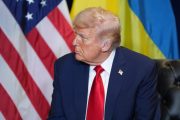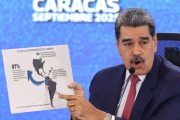Rome. January 897. Pope Stephen VII commands that the corpse of his predecessor, Pope Formosus, be dug up and hauled into a papal court to stand trial. Pope Stephen has deacons adorn the disinterred body in papal robes, prop it up on a throne, and appoints one of the deacons to act as the voice of the inanimate accused.
Formosus was charged with having violated canon law, of having lied to the pope about his role in a Bulgarian uprising, and of having acted as a priest after having agreed to live forever as a layman.
At the trial (known to history as the Cadaver Synod), the corpse of Formosus was found guilty. Upon declaration of the finding, Pope Stephen commanded the deacons to strip the corpse of its papal vestments, sever three fingers of the right hand that Formosus had used in performing consecrations, and posthumously voided all the acts and rulings of Formosus.
Later, after having been buried in a public grave reserved for non-citizens, and as an act of ultimate humiliation, the body was ordered exhumed, laden with weights and cast in the Tiber River.
On Sunday, the Obama administration symbolically dug up the body of Anwar al-Awalaki and tried him for his crimes. Not in front of a court of law, but in the court of public opinion with the New York Times serving as the official court recorder.
In the article published Sunday, Mark Mazzetti, Charlie Savage, and Scott Shane begin by describing the assassination of Awlaki, an American citizen living in Yemen.
The trio label Awlaki as a “firebrand preacher, born in New Mexico, who had evolved from a peddler of Internet hatred to a senior operative in Al Qaeda’s branch in Yemen.” As in the case of Pope Formosus, Awlaki is unable to answer charges that he played such a role in the terrorist organization because he is dead. Undaunted by this seemingly insurmountable obstacle, President Obama in the role of Pope Stephen continues to lay out the evidence of the corpse’s guilt.
Defending the attack as the just result of “years of painstaking intelligence work, [and] intense deliberation by lawyers working for President Obama,” the authors recount that Predator drones targeted Awlaki and Samir Khan (another American living in Yemen suspected of fomenting terror against the United States), and a pilot “thousands of miles away” fired missiles from a Reaper drone, killing Awlaki and Khan.
Now that the duo is dead and have no chance of answering the charges made against them by the Obama administration, the 21st-century version of the Cadaver Synod begins, with Mazzetti, Savage, and Shane playing their part in the charade, reading back to “the court” the record of the sins of the accused Americans.
The paper’s version of the events leading up to the Obama administration’s assassination of Awlaki and Khan are not the sort of pantomime, pro forma defense by deacons, as was witnessed at the Cadaver Synod, rather it is merely a cleverly compiled and repackaged, reworded recitation of the myriad justifications already provided by the president and his surrogates.
For example, the Times article mentions the Justice Department “white paper.” This document, they insist, summarized the “abstract legal arguments” finally settled on by the White House. The problem with this bit of testimony, however, is that the Justice Department’s reasoning is just more of the same old, same old when it comes to defending the president death-by-drone program.
Without citing names of the participants in any of these confabs or the positions they took, the “white paper” throws up another shield of anonymity that has become the gambit of choice for a president determined to assume unto himself all power over life and death. Then, when facing charges of being an imperial president or of being a despot, the president orders his legal lictors to toss out this melange of lawyerly feints.
The message is clear: “Let them eat white paper!”
If that doesn’t satisfy the masses, there’s plenty of newsprint to serve as a second course.
Given, as Glenn Greenwald points out in the Guardian, the “unprecedented fervor and frenzy” with which President Obama has persecuted whistleblowers who have dared pull the classified curtain off the questionable acts of his administration, it is telling that there is no such gnashing of teeth when the paper of record publishes a lengthy article citing several anonymous “current counterterrorism officials.” It is likely that as Greenwald suggests, such punishment is “reserved for those who embarrass rather than glorify the president.”
The monarchical mien of this president is astounding. He refuses to submit his reams of legal justifications to any court of law, rather he orders the military to carry out his fatal decree then orders others in his service to talk to the New York Times. The president’s preference for posthumous media explanations over constitutionally required indictments is an effrontery to this Republic and the rule of law upon which it was once founded.
It is no hypothetical court to which this president has refused to accede. In 2010, the American Civil Liberties Union (ACLU) and the Center for Constitutional Rights brought a lawsuit on behalf of Al-Awlaki’s father, “challenging the government’s asserted authority to carry out ‘targeted killings’ of U.S. citizens located far from any armed conflict zone.” The case was dismissed in federal district court in December 2011 after the Obama administration successfully argued that any disclosure would violate the “state secret” privilege.
Following the publication of Sunday’s article, the ACLU and Center for Constitutional Rights issued the following response:
In anonymous assertions to The New York Times, current and former Obama administration officials seek to justify the killings of three U.S. citizens even as the administration fights hard to prevent any transparency or accountability for those killings in court. This is the latest in a series of one-sided, selective disclosures that prevent meaningful public debate and legal or even political accountability for the government’s killing program, including its use against citizens.
Government officials have made serious allegations against Anwar al-Aulaqi, but allegations are not evidence, and the whole point of the Constitution’s due process clause is that a court must distinguish between the two. If the government has evidence that Al-Aulaqi posed an imminent threat at the time it killed him, it should present that evidence to a court.
But President Obama is above the law. He flouts the Bill of Rights and its protection of the most basic requirement that certain processes — due processes — are met before a person is deprived of life, liberty, or property.
Rather than submitting his suspicions to the “ladies and gentlemen of the jury,” President Obama has assumed autocratic power over the determination of guilt and innocence, declaring “off with his head” of anyone whose name is added to the kill list.
The “trial” is over and the corpse of Anwar al-Awlaki has been found guilty. The justifications will continue to multiply, amounting to nothing less than the severing of long-dead fingers. Unlike in the case of Pope Formosus, however, the 21st-century high priest of unconstitutional killing will not tie stones to the body of the accused and drown him in the Tiber, but will wrap the remains in newsprint and drown him in ink.
Joe A. Wolverton, II, J.D. is a correspondent for The New American and travels frequently nationwide speaking on topics of nullification, the NDAA, and the surveillance state. He can be reached at [email protected].




